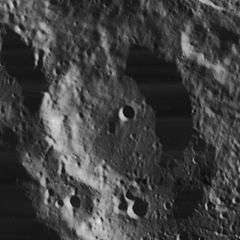Short (crater)
Short is a lunar impact crater that is located in the southern regions of the Moon, on the near side. It lies just to the south of the larger, prominent crater Moretus, and northeast of Newton.
 Lunar Orbiter 4 image | |
| Coordinates | 74.6°S 7.3°W |
|---|---|
| Diameter | 70 km |
| Depth | 5.7 km |
| Colongitude | 350° at sunrise |
| Eponym | James Short |
This crater lies across an older crater designated Short B. Only the eroded southeastern section of the rim of Short B still survives. There is a cluster of small craters attached to the outer rim within the attached Short B.
Short itself is an eroded formation with a somewhat uneven outer rim. The inner wall is more narrow to the southeast and wider elsewhere. Several tiny craterlets lie along the rim edge, as well as the inner wall and floor. At the midpoint of the interior floor of Short is a low central rise. A small crater lies along the northeast edge of this hill.
Satellite craters
By convention these features are identified on lunar maps by placing the letter on the side of the crater midpoint that is closest to Short.
| Short | Latitude | Longitude | Diameter |
|---|---|---|---|
| A | 76.9° S | 0.5° W | 34 km |
| B | 75.5° S | 5.0° W | 71 km |
References
- Andersson, L. E.; Whitaker, E. A. (1982). NASA Catalogue of Lunar Nomenclature. NASA RP-1097.CS1 maint: ref=harv (link)
- Blue, Jennifer (July 25, 2007). "Gazetteer of Planetary Nomenclature". USGS. Retrieved 2007-08-05.CS1 maint: ref=harv (link)
- Bussey, B.; Spudis, P. (2004). The Clementine Atlas of the Moon. New York: Cambridge University Press. ISBN 978-0-521-81528-4.CS1 maint: ref=harv (link)
- Cocks, Elijah E.; Cocks, Josiah C. (1995). Who's Who on the Moon: A Biographical Dictionary of Lunar Nomenclature. Tudor Publishers. ISBN 978-0-936389-27-1.CS1 maint: ref=harv (link)
- McDowell, Jonathan (July 15, 2007). "Lunar Nomenclature". Jonathan's Space Report. Retrieved 2007-10-24.CS1 maint: ref=harv (link)
- Menzel, D. H.; Minnaert, M.; Levin, B.; Dollfus, A.; Bell, B. (1971). "Report on Lunar Nomenclature by the Working Group of Commission 17 of the IAU". Space Science Reviews. 12 (2): 136–186. Bibcode:1971SSRv...12..136M. doi:10.1007/BF00171763.CS1 maint: ref=harv (link)
- Moore, Patrick (2001). On the Moon. Sterling Publishing Co. ISBN 978-0-304-35469-6.CS1 maint: ref=harv (link)
- Price, Fred W. (1988). The Moon Observer's Handbook. Cambridge University Press. ISBN 978-0-521-33500-3.CS1 maint: ref=harv (link)
- Rükl, Antonín (1990). Atlas of the Moon. Kalmbach Books. ISBN 978-0-913135-17-4.CS1 maint: ref=harv (link)
- Webb, Rev. T. W. (1962). Celestial Objects for Common Telescopes (6th revised ed.). Dover. ISBN 978-0-486-20917-3.CS1 maint: ref=harv (link)
- Whitaker, Ewen A. (1999). Mapping and Naming the Moon. Cambridge University Press. ISBN 978-0-521-62248-6.CS1 maint: ref=harv (link)
- Wlasuk, Peter T. (2000). Observing the Moon. Springer. ISBN 978-1-85233-193-1.CS1 maint: ref=harv (link)